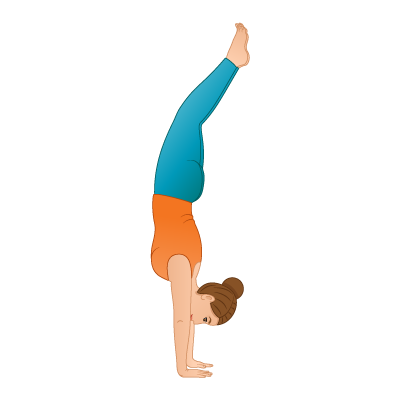Handstand
Adho Mukha Vrksasana

STEPS
Begin in downward facing dog (Adho Mukha Svanasana). Walk the feet towards the hands. Bend the left knee and use the left foot as a springboard to swing the right leg up over the hips and shoulders. Then extend the left leg straight up. Lift up through the arms, shoulders, torso and legs. To come out of the pose, lower one leg and then the other to the ground. Return to downward facing dog. Repeat on the other side using the right leg as a spring.
TEACHER QUEUES
VISUALIZATION COMMENTS
Hand stand is raised arms pose (Hasta Uttanasana) upside down. You might begin with raised arms pose, bringing awareness to rooting the feet and lifting up through the inner arches, torso and arms. Hand stand requires a similar but reverse action – with the hands rooting down. Begin in downward facing dog to practice rooting and lifting up through the arms, shoulders, torso and then arches of the feet. Most students will need to practice split dog, then jumping with one leg bent and the other straight before they are able to maintain the full balance. The phrase, `one leg bent for spring, the other straight for swing’ will remind them of the dynamic actions at work. First time hand standers will benefit from practicing near a wall – with the fingers a few inches from the wall and fingers pointed straight ahead. To conquer the fear factor, you might use phrases such as, `imagine an invisible wall is behind you’ or `imagine a golden string pulling the soles of the feet up towards the sky.’
TECHNICAL COMMENTS
Begin in downward facing dog. Spread the fingers and press the fingertips into the ground rooting the hands and activating both arms and shoulders. Walk the feet towards the hands until the shoulders come over the wrists. Bend one leg and hop off the foot, bringing the hips over the shoulders and swinging the straight leg upwards. Practice the bent leg hop 3 times on each side. Straighten the bent leg and stretch both legs along the wall. Keep the shoulders blades broad and lifted, externally rotating the upper arms to open up the thoracic spine area. Eye gaze is on the ground (between the hands). Remain in the pose for 10 breaths, lifting up from the finger tips, through the arms, shoulders, torso, legs and arches of the feet. The wrists, shoulders, hips, legs and feet need to be in one straight line to hold the balance.
BENEFIT COMMENTS
- Strengthens wrists, arms, shoulders.
- Stretches the belly.
- Improves balance.
- Balances the nervous system.
- Relieves mild depression and anxiety
WATCH OUT FOR
- Collapsing arms (use strap around upper arms).
- Fingers pointing out (fingers should be pointing straight).
- Running starts (Begin with hands rooted).
- Flaying legs (one leg is bent for spring, the other is straight for swing).
CONTRAINDICATIONS
- Back, wrist or shoulder injury.
- Neck injury.
- Pregnancy and Menstruation.
- Headache.
- Heart condition or high blood pressure
MODIFICATIONS
- For beginners it is advisable to practice against a wall.
- For intermediates, students might practice with a partner to stand behind and hold (but never hauls up) the swing leg and then the other.
VARIATIONS
- Bunny hop – Both legs are bent and used to spring or hop up, lifting hips over shoulders and then straightening legs up into handstand.
- Begin in Prasarita Padottanasana (wide straddle forward bend) straighten the arms and press up into handstand
YOGA COUNTER POSES
- Downward facing dog (Adho Mukha Sanasana).
- Raised arm pose (Hasta Uttanasana).
- Child pose (balasana).
- Forward bend (paschimottasana)
Written By: Brenda Hamlet, RYT 200
Brenda Hamlet, is teacher and journalist in Oxford, England. More information about Brenda can be found at www.pret-a-yoga.com



